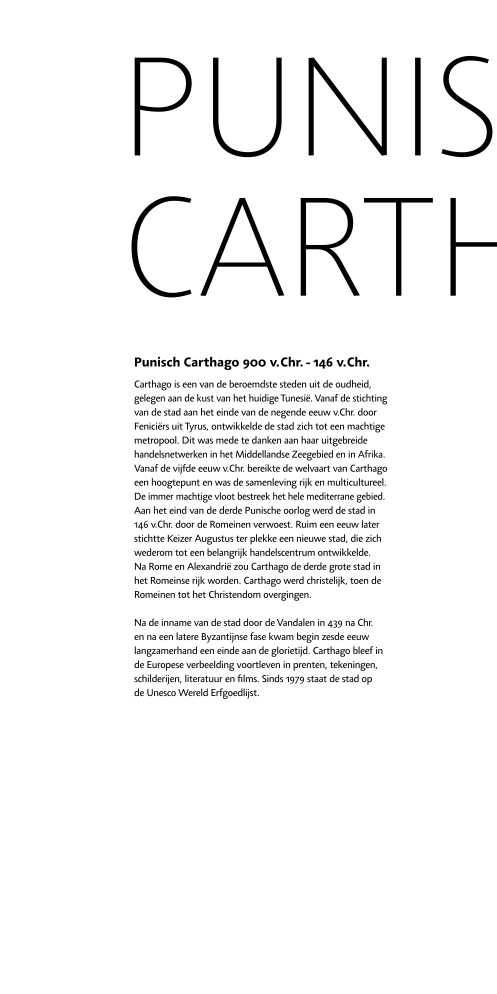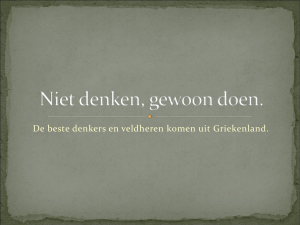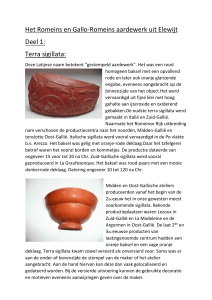
PUNIS
CARTH
Punisch Carthago 900 v.Chr. - 146 v.Chr.
Carthago is een van de beroemdste steden uit de oudheid,
gelegen aan de kust van het huidige Tunesië. Vanaf de stichting
van de stad aan het einde van de negende eeuw v.Chr. door
Feniciërs uit Tyrus, ontwikkelde de stad zich tot een machtige
metropool. Dit was mede te danken aan haar uitgebreide
handelsnetwerken in het Middellandse Zeegebied en in Afrika.
Vanaf de vijfde eeuw v.Chr. bereikte de welvaart van Carthago
een hoogtepunt en was de samenleving rijk en multicultureel.
De immer machtige vloot bestreek het hele mediterrane gebied.
Aan het eind van de derde Punische oorlog werd de stad in
146 v.Chr. door de Romeinen verwoest. Ruim een eeuw later
stichtte Keizer Augustus ter plekke een nieuwe stad, die zich
wederom tot een belangrijk handelscentrum ontwikkelde.
Na Rome en Alexandrië zou Carthago de derde grote stad in
het Romeinse rijk worden. Carthago werd christelijk, toen de
Romeinen tot het Christendom overgingen.
Na de inname van de stad door de Vandalen in 439 na Chr.
en na een latere Byzantijnse fase kwam begin zesde eeuw
langzamerhand een einde aan de glorietijd. Carthago bleef in
de Europese verbeelding voortleven in prenten, tekeningen,
schilderijen, literatuur en films. Sinds 1979 staat de stad op
de Unesco Wereld Erfgoedlijst.
CH
HAGO
Punic Carthage 900 BC - 146 BC
Carthage is one of the ancient world’s most famous cities.
Situated on the shores of what is now Tunisia, it was
founded in the late ninth century BC by Phoenicians from
Tyrus. The inhabitants of Carthage established extensive
trading networks in the Mediterranean region and Africa,
and the city grew into a mighty metropolis. From the fifth
century BC Carthage’s wealth increased and a dynamic,
multicultural society evolved. The mighty Carthaginian
fleet controlled large areas of the Mediterranean.
Carthage was eventually destroyed by the Romans in
146 BC, at the end of the Third Punic War. Over a century
later Emperor Augustus founded a new city, which also
developed into an important trading centre. Carthage
became the third largest city in the Roman empire, after
Rome and Alexandria. The city turned Christian when the
Romans adopted Christianity.
The capture of Carthage by the Vandals in 439 BC and a
later Byzantine phase, was followed by a period in which
the city’s glory days slowly came to an end. Carthage was
kept alive in the European imagination by prints, drawings,
paintings, literature and films. The ruins of Carthage have
been on the Unesco World Heritage List since 1979.
ROME
CARTH
Romeins Carthago vanaf 146 v.Chr.
Na de vernietiging van Carthago in 146 v.Chr. was het in
eerste instantie de bedoeling de stad nooit meer op te bouwen.
Al gauw ging men er anders over denken. Onder Keizer
Augustus groeide het nieuwe Romeinse Carthago snel uit tot
een grote metropool. De stad werd wederom het centrum van
een groot handelsnetwerk. Ook in de latere Christelijke tijd
bleef Carthago belangrijk.
INS
HAGO
Roman Carthage from 146 BC
After the destruction of Carthage in 146 BC at first the
intention was to never rebuild the city again. After some time
this changed. Under emperor Augustus the new Roman
Carthage quickly grew into a metropole. Again the city
became the pivot of an extended trading network. In the
Christian era, Carthage remained a city of importance.












